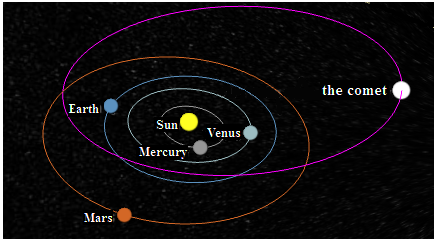The smallest celestial objects sometimes change their state of orbit or spin, says S.Ananthanarayanan.
The night sky has been long regarded as unchanging and even planets, the objects that move, are remarkably regular in their motion. We do know that the earth has been gradually slowing in its rate of spin and gently closing in towards the sun in its orbit. But the change is imperceptible and the cosmos has been a legendary ideal of constancy.
This is, however, is more true of large objects, like planets and stars, than of smaller objects, like comets. Smaller objects are affected by the gravitational pull of larger objects that they pass, by impacts with dust or even of changes in their own structure. A major earthquake would not affect the movement of planet earth, but this is not true of an object only a few kilometers across. Dennis Bodewits, tony L. Farnham, Michael S. P. Kelley and Matthew M. Knight from the Department of Astronomy, University of Maryland, report in the journal, Nature, the changes in the spin state of a Jupiter family comet, 41P/Tuttle–Giacobini–Kresá, known since 1858 and named after its three independent discoverers.
The spin of celestial objects arises from the way they were formed. The matter in the universe started from just gas, mainly hydrogen, and formed when the gas collapsed on itself due to gravity. Any motion within the gas or which was introduced during the collapse got magnified as dimensions reduced, and all the stars, galaxies or planets that we know of have a rate of spin. Even objects that broke away from other objects are ejected with spin. Objects that are in stable orbits also owe their stability to their spin, in the same way that a rifle bullet is imparted spin to keep it steady during its flight to its target.
Spinning objects, however, can change their rate of spin if they change the distribution of the spinning mass within themselves. We may be familiar with the ballerina, or the figure skater, who spin faster or slower by moving their arms towards or away from themselves. Movement of large masses in the crust of or within a planet can bring about a change in the rate of spin. The time it takes for such shifting of mass, however, is in centuries and we have not observed instances in recent history.

Things are different with small objects in space, like comets. In low mass objects which are just kilometers in dimensions, the forces of gravity are not strong and the structure of the objects is not firm. A flow of material, erosion, etc, can hence bring about collapse or re-alignment of large parts of the object and this would affect its rate of spin.
Another effect with objects of long orbits is that they are sometimes close to a mother star and most of the time very far away. Material hence vaporizes during the time the object is near the star, but freezes when it is far away. We can imagine that this would cause flow of matter and changes in the shape of the object.
The comet, 41P/Tuttle–Giacobini–Kresák goes around the sun once every four and a half years. It is only 1.4 km in diameter and can be seen only through a telescope. A particular feature of the comet is that it has been periodically flaring up. In 1973, the flare was dramatic and the comet became visible to the naked eye. The University of Maryland researchers report another feature in their paper - that the rotation of 41P has been slowing down, over measurements made just two months apart, and they suggest the processes in the comet that may be responsible.

The first measurement was in March 2017 using the 4.3 metre and 36 megapixel imager at the Lowell Observatory, Arizona. From 6th to 9th March, the time taken for a rotation was found increase from 19.75 hours to 20.05 hours. The next measurement was in May 2017, using the ultra violet telescope aboard the robotic spacecraft, Swift, from some 7,000 km above the earth. The time of rotation in May was found to be between 46 and 60 hours. By and large, there seems to be a slowing down by about half an hour every day!
Measuring the period of rotation of a comet, when it is near the sun and covered with gas and vapour has its own challenge. There is no visible feature that can be seen to be going round, to help discover the time taken. In the measurements of March 2017, the feature used was plumes of cyanogen gas that the comet emits from the side that it towards the sun. When the comet rotates, the gas comes out in spirals. These can be detected, as cyanogen and the products of its exposure are fluorescent in sunlight. The measurements in May were of the light that came from a large area around the comet, with the rise and fall of the intensity indicating the speed of rotation.
This kind of indirect measurement is used even to assess the rotation of the gas giant planets, Jupiter and Saturn, where physical features cannot be seen. The case of Jupiter is simpler, as the magnetic axis of the planet is a pointer that rotates. In the case of Saturn, however, the magnetic axis is almost along the axis of rotation. It is with the help of faint radio emission of charged particles in the atmosphere, and the variation in the planet’s gravitational field, that the speed of rotation could be worked out.
While the speed of rotation of many comets has been measured, it is in just a few cases that there has been a conclusive change, the paper says. The rapidity of slowing of 41P, however, outstrips the others by a wide margin. The paper notes that the small size of 41P, and the indications that water production is active in about 50% of its surface, in contrast with just 3% in other comets, may be the reason. But then, there are similar instances that have not shown comparable slowing of rotation.
Further analysis shows that the reason could be that the much of the gases emitted by the comet is in the direction opposed to the rotation. Emission of gases along the axis of rotation, or where the emission from different places cancel out, would not affect the speed of rotation., “The active regions on the surface of comet 41P are probably oriented in such a way that its torques are highly optimized in comparison to many other comets,” the paper says.
The team has extrapolated backwards the fall in the speed of rotation and the find that the speed must have been very high in the not so distant past. When an object rotates fast, its surface material experiences high centrifugal or ‘centre-fleeing’ forces. This is like how we are thrown towards the far side of a car when it takes a sharp turn. Now, in a small celestial object, the force of gravity is feeble and the material at the surface is not strongly bound. A fast rate of rotation would this cause disturbances, fragmentation and landslides. It could have been such events that led to the high luminosity seen in 1973 and again in 2001. It could even be that these events exposed new areas to emit gases and oppose spin, leading to slowing of rotation, the paper says.
------------------------------------------------------------------------------------------ Do respond to : response@simplescience.in